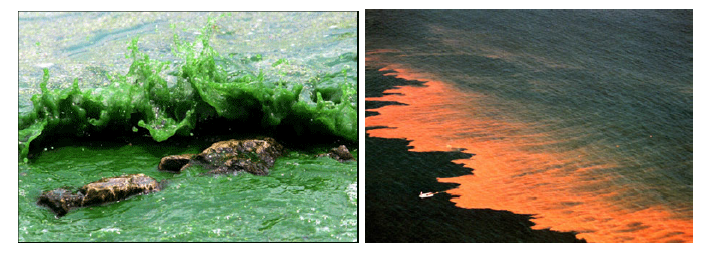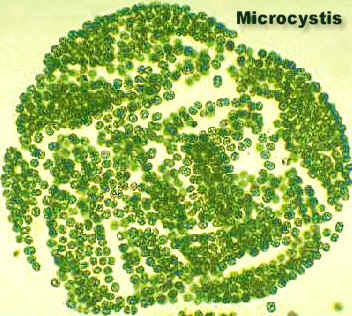| With the rapid development of my country's economy, the ecological environment continues to deteriorate.In recent years, Harmful Algal Blooms (HABs) (including marine red tides and freshwater blooms) in my country's water bodies have continued to occur frequently, which has seriously affected residents' drinking water safety, aquaculture, water landscape value, etc., resulting in Huge economic losses.Government departments and scientific research institutions at all levels in my country have increasingly strong demands to quickly monitor the dynamic changes of phytoplankton communities in water bodies and early warnings of freshwater cyanobacteria blooms and marine diatoms/dinoflagellate red tides. | ||
| ||
| Existing methods and limitations | ||
At present, the monitoring of phytoplankton and harmful algae blooms in my country mainly uses technologies such as microscopic counting, chlorophyll content determination, satellite remote sensing, and algatoxin monitoring. The samples collected by traditional microscopy need to be fixed by Luger's solution, formaldehyde and other fixative solutions, and then taken back to the laboratory to precipitate and concentrate for qualitative quantitative analysis, which takes a long time.Due to the limitations of focused gold and depth of field, traditional optical microscopes can only measure samples of very small volumes and cannot be measured in situ underwater. Chlorophyll content determination is a relatively fast and simple measurement technology, but traditional measurement methods are mostly taken back to the laboratory for extraction after on-site suction filtration, and then subjected to spectrophotometer analysis, fluorescence spectrophotometer analysis or high-performance liquid color.(HPLC) analysis, but this technique takes as fast as 1-2 days to obtain results.Neither of these methods can reflect the algae information in the water immediately, but will have to go through a period of analysis, which will reduce the timeliness of biological monitoring and greatly affect the monitoring/early warning of harmful algae blooms.In addition, the determination of chlorophyll content can also be continuously monitored by in-situ sensors, but this method often uses the Rhodamine method (chemical method) to correct data, with large errors and the sensor needs frequent maintenance. Satellite remote sensing has the advantages of wide monitoring range, many data, and not limited by geographical location and artificial conditions, but it is easily affected by weather conditions and often requires the accumulation of algae cells to a certain extent (algae blooms may have occurred) to be monitored.The effect of early warning cannot be achieved, and the purchase of satellite remote sensing data is expensive and the analysis is complicated. Therefore, satellite remote sensing is mostly carried out in professional institutions. Algatoxin monitoring currently mainly uses HPLC and ELISA methods. Both methods can accurately measure the algatoxin content in water, but both require manual collection of samples and bringing them back to the laboratory to extract toxins. The process is complicated and the speed is slow., and cannot be monitored automatically and continuously for a long time.Even if no toxin was detected in both samples, it is not guaranteed that the interval algae of the two samples did not produce toxins or that the toxins were not released into the water. | ||
newMonitoring function of the scheme | ||
ComePHYTO-PAM-II is used to measure the chlorophyll a content and total chlorophyll a content of cyanobacteria, green algae, silicon/dinoflagellate and cryptoalgae on site, as well as their photosynthetic activity ("Growth potential”) ComeUse water quality multi-parameter instrument and float monitoring platform to quickly or in real time to monitor the eutrophication trend of water bodies ComeUse portable phytoplankton flow cytometer CytoSense or underwater phytoplankton flow cytometer CytoSub to quickly count the number of phytoplankton cells, and obtain the cell concentration, cell size, and cell morphology information of the main taxa; learnChanges in population (cystic) dynamics of microcystis, cystis palmitus, etc.Situation; for chain algae,Measure the number of cells per chain;For diatoms, dinoflagellates and other algae with special shapes,Rapid identification based on the phytoplankton expert database ComeuseCytoSense-Online system orOnline monitoring phytoplankton flow cytometer CytoBuoy conducts long-term continuous monitoring of phytoplankton in water ComeUsing the online monitoring system of toxin-producing algae and algatoxins, ESP, underwater, use molecular probe technology and immune technology to monitor the changes of toxin-producing algae and algatoxins in situ and long-term | ||
| The early warning function of the new solution | ||
ComeWarning is made according to the change trend of chlorophyll a content and cell number ComeMonitor eutrophication waters according to changes in water quality ComePhotosynthetic activity (“growth potential”) of phytoplankton indicates future growth potential. Phytoplankton with high photosynthetic activity and strong light resistance is more likely to develop algae when environmental conditions (nutrients, light, temperature) are suitable. ComeAlgae with cysts such as microcystis, palm cystis, etc. do not form cysts and do not produce algae blooms. CytoSense and other uses long-term monitoring of changes in the "cysts" such as microcystis, palm cystis, etc. in water bodies and provide early warnings. ComeEarly warning is made based on changes in toxin-producing algae and algatoxins (closely related to water supply and aquaculture!!) | ||
| Equipment and uses required for the new solution | ||
1)Phytoplankton fluorescent instrument PHYTO-PAM-Ⅱ UQuickly automatically qualitatively (classified) quantification of cyanobacteria, green algae, silicon/dinoflagellate and cryptoalgae in water samples on site (measure chlorophyll a) UQuickly measure cyanobacteria, green algae, silicon/ditaceae on site, cryptoalgaePhotosynthetic activity ("growth potential") 2)Xylem portable water quality multi-parameter detector U550A portable dissolved oxygen measuring instrument UProODO optical dissolved oxygen measuring instrument UYSI ProPlus multi-parameter water quality measuring instrument UpH100A portable pH meter 3)GreenEyes Nutrient In-situ Monitoring System (EcoLABⅡ, Nulab4) UApply wet chemistry in the field UObserve the changes in the growth factors of nitrogen and phosphorus in water in real time 4)Ocean/freshwater buoy ecological monitoring system URealize real-time monitoring of hydrological water quality UOnline monitoring of chlorophyll and phytoplankton in water 5)CytoBuoy series of phytoplankton flow cytometry (CytoSense, CytoBuoy, CytoSub) UQuickly count the total number of phytoplankton cells in water UQuickly obtain information on phytoplankton cell populations (concentration, size, group, and species) on site UQuickly measure the number of cells such as microcystis, cystis palmitus and the proportion of "cystis" on site 6)Toxic-producing algae and algatoxin online monitoring system ESP ULong-term, automatic and continuous monitoring of changes in toxin-producing algae and/or algatoxins ULong-term, automatic and continuous monitoring of changes in specific algae, bacteria, zooplankton, etc. UProvide customized molecular probe combination sets to perfectly solve customers' special needs UMonitoring results can be transmitted wirelessly to the shore base station UCan work underwater in situ (tolerant of 50m water pressure), or in monitoring platforms or water station buildings USamples can be collected and stored underwater, and then recovered in the laboratory | ||
| Principle of Algaeization Warning Using Photosynthetic Activity of Phytoplankton | ||
The growth of algae depends on photosynthesis. The explosion of algae blooms is caused by the rapid short-term increase of algae under specific environmental conditions (nutrition, high light, high temperature). During this period, algae must have extremely strong photosynthesis to grow rapidly. Monitoring chlorophyll a content allows you to understand the algae biomass in the current water body, but this only represents history (if the nutrient salt is very low, even if the current algae biomass is high, there is no possibility of algae blooms); while monitoring the photocooperation of algae Using activity can understand the "growth potential" of algae, and combining with other environmental conditions, we can predict the future (nutritional conditions and high light and high temperatures. Even if the current algae biomass is not high, as long as the photosynthesis activity is strong, it will have great the possibility of algae blooms).Due to PHYTO-PAM-ⅡThe photosynthesis of cyanobacteria, green algae, silicon/dinoflagellate and cryptoalgae in natural water samples can be measured, and different algae groups can be analyzed when algae blooms occur.Utilize PHYTO- Pam-ⅡThe function of measuring the chlorophyll a content and photosynthesis activity of different algae can monitor the dynamic changes in the biomass of phytoplankton populations in natural water bodies for a long time and the changing trends of photosynthesis potential of different groups, which is for algae Hua's early warning has important reference value. |
| |
| Principle of Algaeization Warning Using Phytoplankton Flow Cytometry | ||
Cyanobacteria water blooms are mostly caused by microcystis, and the premise for microcystis to form a water bloom is that algae cells gather to form a population ("cystis") and float to the surface.Without the formation of population cells, water blooms will not be formed.The population of microcystis is relatively large, and general flow cytometry cannot be directly injected and measured, but the CytoBuoy series of phytoplankton flow cytometry can be directly injected and measured, and the particle size of the population cells and the population size of different sizes can be obtained.proportion.Starting from spring, regularly monitoring the changes in particle size and proportion of microcystis population cells in different aqueous layers can provide early warning of microcystis blooms.When the proportion of population cells increases and migrates from the lower water surface, it indicates that the conditions for forming water blossoms are gradually mature, and early warning plans can be initiated. Some cyanobacteria blooms or marine red tides are formed by chain cells.For these cells, the length of the cell chain helps the algae increase buoyancy and obtain sufficient light. If nutrients are abundant and meteorological conditions are appropriate, algae with long cell chains are more likely to form water blooms.Therefore, using the CytoBuoy series phytoplankton flow cytometer to measure the length of the cell chain can be used for water bloom warning. For special-shaped red tide diatoms and dinoflagellates, an expert database can be established using the CytoBuoy series of phytoplankton flow cytometry, which can quickly screen/warn harmful algae for natural water samples. | ||
| Harmful algae bloom monitoring/early warning prospect | ||
In summary,Phytoplankton fluorescent instrument PHYTO-PAM-Ⅱ, portable water quality/online monitoring technology,CytoBuoy series phytoplankton flow cytometry andThe online monitoring system of toxin-producing algae and algatoxins ESP has great application potential in monitoring/early warning of harmful algae blooms:PHYTO-PAM-II focuses on understanding biomass and photosynthetic activity based on automatic classification("Growth Potential"); Underwater in-situ nutrient system applies wet chemistry methods to the field, and observes changes in algae growth factors such as nitrogen and phosphorus in water bodies in real time. Water quality multi-parameter monitor and float online monitoring system can quickly and in real time monitorDynamic changes in water quality hydrological elements;CytoBuoy focuses on cell counting specifically for phytoplankton, and can directly measure microcystis, and species can be identified for special-shaped algae; ESP focuses on long-term, continuous and online monitoring of toxin-producing algae and algatoxin.The four counting types are currently the most cutting-edge technologies in the world, and the instruments are all designed for field applications, fully taking into account the difficulties of on-site monitoring.Four technologies can be used separatelyMonitoring/warning of harmful algae blooms, if combined, will have better effect on monitoring/warning.I believe that the four technologies will play a great role in monitoring/early warning of harmful algae blooms in our freshwater and ocean environments. | ||

